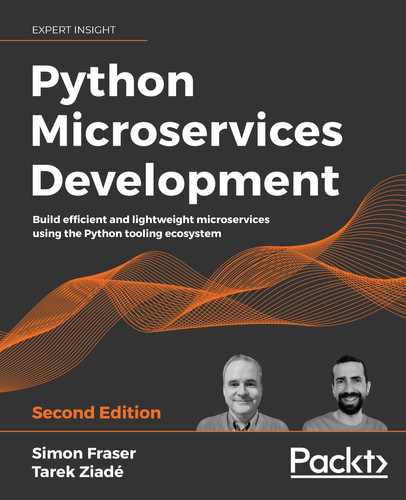Use Python microservices to craft applications that are built as small standard units using proven best practices and avoiding common errors The small scope and self-contained nature of microservices make them faster, cleaner, and more scalable than code-heavy monolithic applications. However, building microservices architecture that is efficient as well as lightweight into your applications can be challenging due to the complexity of all the interacting pieces. Python Microservices Development, Second Edition will teach you how to overcome these issues and craft applications that are built as small standard units using proven best practices and avoiding common pitfalls. Through hands-on examples, this book will help you to build efficient microservices using Quart, SQLAlchemy, and other modern Python tools In this updated edition, you will learn how to secure connections between services and how to script Nginx using Lua to build web application firewall features such as rate limiting. Python Microservices Development, Second Edition describes how to use containers and AWS to deploy your services. By the end of the book, you'll have created a complete Python application based on microservices. This book is for developers who want to learn how to build, test, scale, and manage Python microservices. Readers will require basic knowledge of the Python programming language, the command line, and HTTP-based application principles. No prior experience of writing microservices in Python is assumed.Key Features
Book Description
What you will learn
Who this book is for
Table of Contents
- Preface
- Understanding Microservices
- The origins of service-oriented architecture
- The monolithic approach
- The microservice approach
- Microservice benefits
- Separation of concerns
- Smaller projects
- Scaling and deployment
- Pitfalls of microservices
- Illogical splitting
- More network interactions
- Data storing and sharing
- Compatibility issues
- Testing
- Implementing microservices with Python
- How web services work
- The WSGI standard
- Workers, threads, and synchronicity
- A worker pool approach
- Being asynchronous
- Twisted, Tornado, Greenlets, and Gevent
- Asynchronous Python
- Language performance
- Summary
- Discovering Quart
- Making sure we have Python
- How Quart handles requests
- Routing
- Variables and converters
- The url_for function
- Request
- Response
- Quart's built-in features
- The session object
- Globals
- Signals
- Extensions and middleware
- Templates
- Configuration
- Blueprints
- Error handling
- Custom error handler
- A microservice skeleton
- Summary
- Coding, Testing, and Documentation: the Virtuous Cycle
- Designing Jeeves
- Splitting the Monolith
- Interacting with Other Services
- Calling other web resources
- Finding out where to go
- Environment variables
- Service discovery
- Transferring data
- HTTP cache headers
- GZIP compression
- Protocol Buffers
- MessagePack
- Putting it together
- Asynchronous messages
- Message queue reliability
- Basic queues
- Topic exchanges and queues
- Publish/subscribe
- Putting it together
- Testing
- Using OpenAPI
- Summary
- Securing Your Services
- The OAuth2 protocol
- X.509 certificate-based authentication
- Token-based authentication
- The JWT standard
- PyJWT
- Using a certificate with JWT
- The TokenDealer microservice
- The OAuth implementation
- Using TokenDealer
- Securing your code
- Limiting your application scope
- Untrusted incoming data
- Redirecting and trusting queries
- Sanitizing input data
- Using Bandit linter
- Dependencies
- Web application firewall
- OpenResty: Lua and nginx
- Rate and concurrency limiting
- Other OpenResty features
- Summary
- Making a Dashboard
- Packaging and Running Python
- Deploying on AWS
- What's Next?
- Other Books You May Enjoy
- Index
